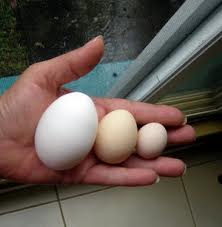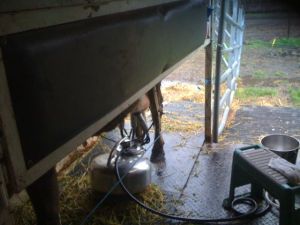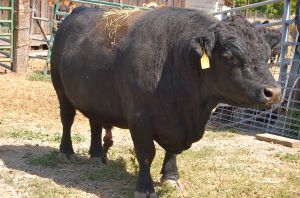Who would have thought that I would be awash in eggs. Just a few short months ago, people were calling for our farm fresh eggs, and I had to tell them that our hens were in a “drought” situation. We hoarded each egg they produced and kept only the very smallest eggs (virgin eggs we call them) for ourselves. It was the holiday months and everyone had guests and wanted to serve up some truly free-range pastured eggs. My newest hens, mostly, had not kicked into laying yet… a few were starting to lay but not reliably.
The first time I had brand new hens start laying… I thought I had made a mistake and gotten the wrong kind of hens. I was getting MICRO eggs! I was so relieved when someone told me that they often start out with tiny eggs, but they should get larger. And sure enough, they did! We started calling those eggs, “virgin eggs”.
Laying Hens
A hen starts laying around 5 months old. Daily (or almost daily) egg laying is triggered by the amount of daylight hours… so in the winter months hens typically stop laying, or greatly reduce their production. On top of that, they are using their food energy for staying warm with the colder, wetter weather. We do provide a balanced layer feed because if a hen’s on forage & don’t get enough of the essentials, they stop laying. But besides access to extra food, to keep our hens laying, we have a light and timer in the barn that serves two functions.
One, it provides a light that the hens are attracted to, so that at night they head to the barn where their protected coop is located. We have had predators come through an avail themselves of the “Heritage Farm” buffet. UGGGH. We got away with letting them roam completely free and then nest in the rafters of the barn, for quite a while, but then paid the price. I lost most of my hens… and had to BUY store-bought eggs.
An Egg SNOB
OMG, that was an education. Organic ,free-range, cage-free eggs, hmmm. Nada. I was really surprised at what a snob I had become. First off, all the labels say “vegetarian feed”… sorry, chickens are not, I repeat, NOT, by nature, vegetarians. Eggs from hens fed that kind of diet are, to me, bland & blah. We were fairly new to the neighborhood, so in desperation, I had to hunt out someone who had real live free-range pastured eggs… and the difference was total. I was back to the rich tasting nutrient dense eggs I was used to. But my hens, now have a light they are attracted to at night, and they go into LOCKDOWN until morning.
Second, the light encourages egg laying during the winter months. Still not as prolific as the rest of the year, as they are using extra energy for their own needs. A hen needs roughly 14 hours of light to produce eggs. She will produce the most eggs her first laying season, molt (shed feathers) & take a break, before picking up again. Each year thereafter she will produce fewer eggs. Most hens are no longer “used” for laying after two years.
Interestingly you can tell who has laid a lot of eggs by the color of their legs!! Hens, of the same breed, have legs of a certain color yellow. The hens with the lightest shade of that yellow will have laid the most eggs. The yellow (beta carotene) gets pulled from the chicken to go into her eggs.
EGG Production
All the eggs the hen will lay, are already there at birth. Just not developed but the germ cell is there. A chicken will have several eggs developing at various stages at once, like a production line. We’ve had a couple of new hens who haven’t gotten the process quite worked out… out pops an egg WITHOUT the shell (just the tough membrane encasing the egg), or all white with no yolk, or double yolks inside one shell. From start to finish, 25 1/2 hrs to produce an egg: It takes about 20 hours for an egg-shell to form around the yolk/membrane, and only 1 minute to actually lay the egg.
I have been told that pastured eggs always have deep, deep orange/yellow yolks. Since all our hens have the same diet, I know that this is NOT true. It depends on the breed of the chicken… they will have varying shades of yellow to deep orange. I do know that veggie fed hens have very pale, tasteless, almost watery egg yolks!
Historically hens would lay up to a 100 eggs a year. Some of the breeds today will lay up to 300-350 eggs; almost an egg a day. These hens have NOT been genetically modified via some scientific voodoo magic; just simple selection for a specific trait. The best bred to the best producers… some traits are left by the wayside. Going broody is definitely a trait NOT bred for.
Some hens will “go broody” meaning they will lay a clutch of eggs and after collecting up to a dozen, will then “sit” (i.e. incubate them for 21 days). She’ll hatch out her chicks and then spend the next two months raising them. But for this three-month period, she is not laying any eggs. You can see why in the commercial industry this mothering behavior is not useful. Me, I WANT the mom to do all the work, because she is MUCH better at it.
Most turkeys cannot breed on their own or raise their own chicks, due to the intensive breeding used to produce big breasted turkeys. They physically cannot do the “deed”. We raise heritage chickens and heritage turkeys to encourage specific traits; breeding and raising their own chicks.
Heritage chickens are fairly easy to get that will go broody and raise a clutch successfully. We’ve had a warm winter and I had TWO hens who marched out from the barn with a clutch of chicks… that I did not even know were nesting. We put a green bracelet on a hen that does this, so I know who I want to keep for eggs production. Some hens will start but not finish, or can’t seem to figure out what to do with the chicks after they are born (sad). I’ll put a yellow band on her so I know she should be discouraged from going broody, and that I do NOT want to incubate any of her eggs.
Turkeys are a basket case
We raise heritage turkeys so they can at least bred and produce fertile eggs. But those eggs we set aside and incubate. I have one turkey hen who is interested in setting so we’ll see if she can manage a clutch this spring.
Right now we have three different breeds of heritage turkeys: midget white, heritage bronze, and what looks like to be a variation on the Royal Palm (white, with some black markings). We have them separated so that we can prevent cross-breeding.
I have had one Heritage Bronze, when we were on the ranch with lots of acreage, that went broody, disappeared , and came back with a clutch of turkey chicks. We were so excited to see this, but the downside of her “disappearing” is that she & her chicks became coyote food. Circle of life, I remind myself! But here on the farm we can have more control.
I’m keeping breeding pairs to encourage egg production… but had to separate the males because they began to fight among themselves. Only the dominate male will mate… with all the available hens. Whoops, not in my plan…. so we had to separate the breeds. Now I just need to get more females of each breed… but that’s a plan for this spring. We have a couple of dozen turkey eggs incubating right now, so we’ll see what we come up with. The extra toms will be on someone’s dinner menu.
Eggs Galore
But now that we’ve past spring equinox… I have eggs galore! Seems like I somehow (I have no idea how.. well, wait.. there were some broody hens last fall…) ended up with close to 40 hens. Rhode Island Reds, Golden Wyandottes, and Dark Cornish who are all great layers, it turns out… and mothers, as well!
It’s time for me to learn how to make mayonnaise! All you need is egg yolks, oil (canola oil, olive oil, etc), and some seasonings (salt, mustard) & a bit of lemon/vinegar with water. And deviled eggs, Quiche’s, egg-cheese casseroles…
Anyone need a few laying hens? I’ve got some to sell!





























































